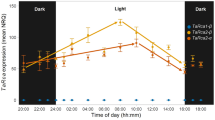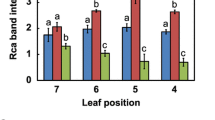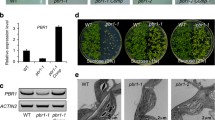Abstract
Plastidic acetyl-CoA carboxylase (ACCase) regulates the rate of fatty acid synthesis. This enzyme is composed of biotin carboxyl carrier protein (BCCP), biotin carboxylase (BC), and carboxyltransferase (CT), which consists of α and β subunits. Among these components, CTβ is encoded by the plastidic genome. In Arabidopsis, BC and CTα are each encoded by a single gene, and there are two genes for BCCP, BCCP1 and BCCP2. Promoter analysis revealed that the 5′-UTR containing the AW box is necessary for the expression of these genes in seeds and seedlings. The results indicated that there are other transcription factors besides WRI1 that bind to the AW box and regulate these genes in organs other than seeds. Although the AW boxes at 748 and 532 bp upstream from the transcription start sites (TSSs) of the BC and CTα genes, respectively, were not functional in seeds, the latter was functional in seedlings. In addition, when these AW boxes were moved to approximately 200 bp upstream from the TSS, they became active in seeds but not in seedlings. These results suggest that the distance from the TSS affects the function of the AW box, and the AW box alone is not sufficient for expression in seedlings. A comparison of the protein levels of BC, BCCP1, BCCP2 and CTβ between a wri1 mutant, a WRI1-overexpressing line and control plants showed that protein levels of BCCP2 and BC but not BCCP1 and CTβ are affected by WRI1. The results suggest that ACCase subunits are differentially regulated by WRI1.










Similar content being viewed by others
References
Andre C, Froehlich JE, Moll MR, Benning C (2007) A heteromeric plastidic pyruvate kinase complex involved in seed oil biosynthesis in Arabidopsis. Plant Cell 19(6):2006–2022
Baud S, Wuilleme S, To A, Rochat C, Lepiniec L (2009) Role of WRINKLED1 in the transcriptional regulation of glycolytic and fatty acid biosynthetic genes in Arabidopsis. Plant J 60(6):933–947
Baud S, Feria Bourrellier AB, Azzopardi M, Berger A, Dechorgnat J, Daniel-Vedele F, Lepiniec L, Miquel M, Rochat C, Hodges M, Ferrario-Mery S (2010) PII is induced by WRINKLED1 and fine-tunes fatty acid composition in seeds of Arabidopsis thaliana. Plant J 64(2):291–303
Cernac A, Benning C (2004) WRINKLED1 encodes an AP2/EREB domain protein involved in the control of storage compound biosynthesis in Arabidopsis. Plant J 40(4):575–585
Clough SJ, Bent AF (1998) Floral dip: a simplified method for Agrobacterium-mediated transformation of Arabidopsis thaliana. Plant J 16(6):735–743
Feria Bourrellier AB, Valot B, Guillot A, Ambard-Bretteville F, Vidal J, Hodges M (2010) Chloroplast acetyl-CoA carboxylase activity is 2-oxoglutarate-regulated by interaction of PII with the biotin carboxyl carrier subunit. Proc Natl Acad Sci USA 107(1):502–507
Focks N, Benning C (1998) wrinkled1: a novel, low-seed-oil mutant of Arabidopsis with a deficiency in the seed-specific regulation of carbohydrate metabolism. Plant Physiol 118(1):91–101
Hajdukiewicz PT, Allison LA, Maliga P (1997) The two RNA polymerases encoded by the nuclear and the plastid compartments transcribe distinct groups of genes in tobacco plastids. EMBO J 16(13):4041–4048
Ke J, Wen TN, Nikolau BJ, Wurtele ES (2000) Coordinate regulation of the nuclear and plastidic genes coding for the subunits of the heteromeric acetyl-coenzyme A carboxylase. Plant Physiol 122(4):1057–1071
Kozaki A, Hake S, Colasanti J (2004) The maize ID1 flowering time regulator is a zinc finger protein with novel DNA binding properties. Nucleic Acids Res 32(5):1710–1720
Li ZG, Yin WB, Song LY, Chen YH, Guan RZ, Wang JQ, Wang RR, Hu ZM (2011) Genes encoding the biotin carboxylase subunit of acetyl-CoA carboxylase from Brassica napus and parental species: cloning, expression patterns, and evolution. Genome 54(3):202–211
Madoka Y, Tomizawa K, Mizoi J, Nishida I, Nagano Y, Sasaki Y (2002) Chloroplast transformation with modified accD operon increases acetyl-CoA carboxylase and causes extension of leaf longevity and increase in seed yield in tobacco. Plant Cell Physiol 43(12):1518–1525
Maeo K, Tokuda T, Ayame A, Mitsui N, Kawai T, Tsukagoshi H, Ishiguro S, Nakamura K (2009) An AP2-type transcription factor, WRINKLED1, of Arabidopsis thaliana binds to the AW-box sequence conserved among proximal upstream regions of genes involved in fatty acid synthesis. Plant J 60(3):476–487
Masaki T, Mitsui N, Tsukagoshi H, Nishii T, Morikami A, Nakamura K (2005) Activator of Spomin:LUC1/WRINKLED1 of Arabidopsis thaliana transactivates sugar-inducible promoters. Plant Cell Physiol 46(4):547–556
Ohlrogge J, Savage L, Jaworski J, Voelker T, Post-Beittenmiller D (1995) Alteration of acyl–acyl carrier protein pools and acetyl-CoA carboxylase expression in Escherichia coli by a plant medium chain acyl–acyl carrier protein thioesterase. Arch Biochem Biophys 317(1):185–190
Ruuska SA, Girke T, Benning C, Ohlrogge JB (2002) Contrapuntal networks of gene expression during Arabidopsis seed filling. Plant Cell 14(6):1191–1206
Sasaki Y, Hakamada K, Suama Y, Nagano Y, Furusawa I, Matsuno R (1993) Chloroplast-encoded protein as a subunit of acetyl-CoA carboxylase in pea plant. J Biol Chem 268(33):25118–25123
Sasaki Y, Konishi T, Nagano Y (1995) The compartmentation of acetyl-coenzyme A carboxylase in plants. Plant Physiol 108(2):445–449
Tabach Y, Brosh R, Buganim Y, Reiner A, Zuk O, Yitzhaky A, Koudritsky M, Rotter V, Domany E (2007) Wide-scale analysis of human functional transcription factor binding reveals a strong bias towards the transcription start site. PLoS ONE 2(8):e807
Thelen JJ, Ohlrogge JB (2002) Both antisense and sense expression of biotin carboxyl carrier protein isoform 2 inactivates the plastid acetyl-coenzyme A carboxylase in Arabidopsis thaliana. Plant J 32(4):419–431
Acknowledgments
We thank K. Nakamura for providing plant materials and Y. Sasaki for providing antisera.
Author information
Authors and Affiliations
Corresponding author
Rights and permissions
About this article
Cite this article
Fukuda, N., Ikawa, Y., Aoyagi, T. et al. Expression of the genes coding for plastidic acetyl-CoA carboxylase subunits is regulated by a location-sensitive transcription factor binding site. Plant Mol Biol 82, 473–483 (2013). https://doi.org/10.1007/s11103-013-0075-7
Received:
Accepted:
Published:
Issue Date:
DOI: https://doi.org/10.1007/s11103-013-0075-7




